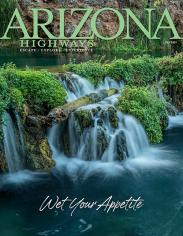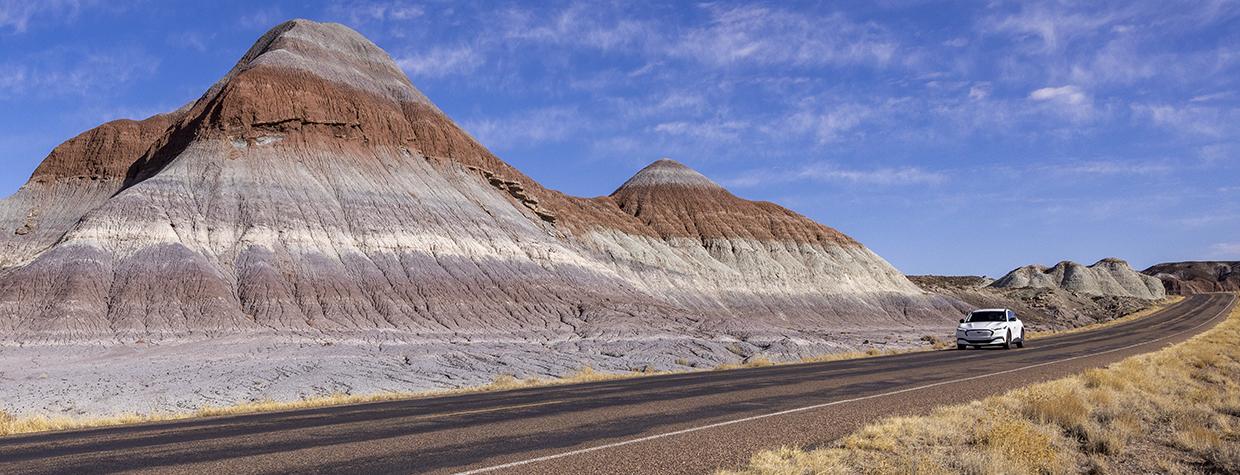“A national park is not a playground,” the late conservationist Michael Frome wrote. “It’s a sanctuary for nature — and for humans who will accept nature on nature’s own terms.”
If we hold that to be true, aren’t electric vehicles an ideal way to explore those sanctuaries? They don’t pump carbon monoxide and other emissions into the atmosphere, and they’re quiet — allowing visitors to enjoy the smells and sounds of nature without the intrusions of gasoline fumes and revving engines.
But Arizona is a big place. And for decades, inadequate infrastructure for charging electric cars has left many of our National Park Service sites, along with large swaths of the nation’s sixth-largest state, out of reach for EVs. Use of these vehicles, though, is growing fast: As noted by the clean-energy advocacy group Climate Power, about 90,000 EVs were registered in Arizona in 2023, up from 66,000 just a year earlier. Now, the roadside infrastructure is catching up, with faster charging stations opening many destinations to these vehicles — and more such stations are planned along Arizona’s highways in the years ahead.
So, how doable is a road trip around Arizona in an EV? To find out, I’m making a three-day, all-electric trek to the state’s three national parks — Grand Canyon, Petrified Forest and Saguaro — and looking at the charging infrastructure along the way. What I’m about to learn is that preparation is essential to making an EV road trip in Arizona successful.
Frome had that topic covered, too: “The largest single reason for disappointing travel experiences is the failure to plan properly.” It’s also the reason you could end up sweating bullets about your EV’s battery somewhere between Holbrook and Show Low. Not that I’d know anything about that.
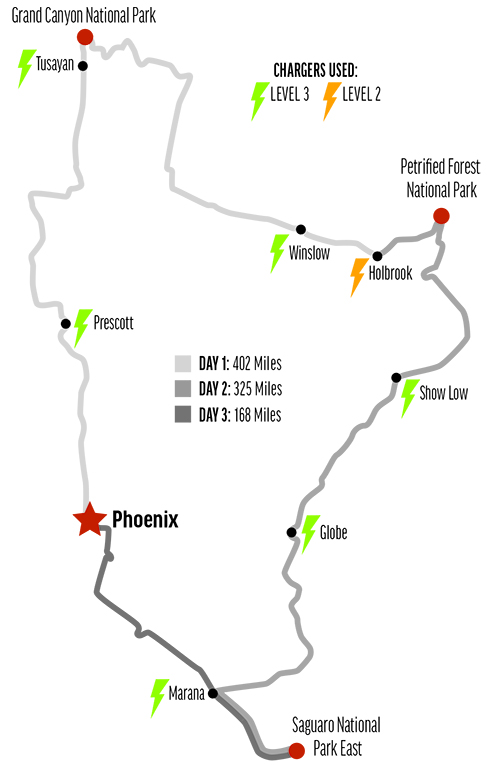
Day 1:
GRAND CANYON NATIONAL PARK
On a sunny Wednesday morning in late February, I set out from downtown Phoenix in a Ford Mustang Mach-E, one of six EVs the Arizona Department of Transportation recently added to its fleet of vehicles used by ADOT employees. (Arizona Highways is a division of ADOT.)
As state fleet administrator, Devin Darlek oversees ADOT’s and other agencies’ vehicles. He says the decision to replace some fleet vehicles with EVs was difficult, given that Arizona’s charging infrastructure has been slow to catch up with the number of electric cars on the road. Cost was a factor, too: The Mustang sells for about twice as much as a similar gas-powered crossover SUV, and the state wants to make sure it’s spending taxpayer money wisely.
“We don’t want to overstep — we’re looking at what makes the most sense for everyone,” Darlek says, noting that the typical EV range of about 200 miles is a fit for ADOT duties close to Phoenix, but not in farther-flung locations. That’s beginning to change, he adds, but the state’s current EV landscape is “kind of like a newborn baby: We know what the baby’s going to be able to do one day, but right now, it has to crawl.”
Crawling is one thing I’m not doing as I zoom up Interstate 17. This is my first time behind the wheel of an electric car, and I quickly learn that a lead foot is one of the fastest ways to drain the battery. Another is going uphill, which means by the time I pass the Sunset Point rest area, I’ve already drained nearly half of my charge.
As planned, I take State Route 69 toward Prescott. I hadn’t intended to charge the car there, but I can sense “range anxiety” creeping in — a charge of 43 percent feels like a lot less than 50 percent to this EV newbie. (For context, according to a survey cited by Climate Power, EV drivers generally feel comfortable until their battery level gets below 30 percent.)
I play it safe by pulling into a Level 3 charging station, the fastest type currently available, near Yavapai College. I get plugged in and charging without much trouble, and then comes my first big surprise: In less than 30 minutes, I’m back up to 80 percent charged, the level at which these devices reduce the charging speed to avoid damaging the battery. Cost-wise, this charge totals about $15 and adds about 75 miles of range, and as the trip continues, I’ll find that ratio remains constant — for example, charging a more depleted battery costs $30 but adds 150 miles of range. (Of note, it’s much cheaper to charge an EV slower, such as overnight at a home charger.)
I head north on State Route 89, then east on Interstate 40, before taking State Route 64 north to Tusayan, just south of Grand Canyon National Park’s South Rim entrance. I arrive around 1 p.m. and plug in at another fast charger, behind the IMAX theater. When I walk back from lunch at a nearby café, the car’s charge has gone from 23 to 90 percent in 45 minutes.
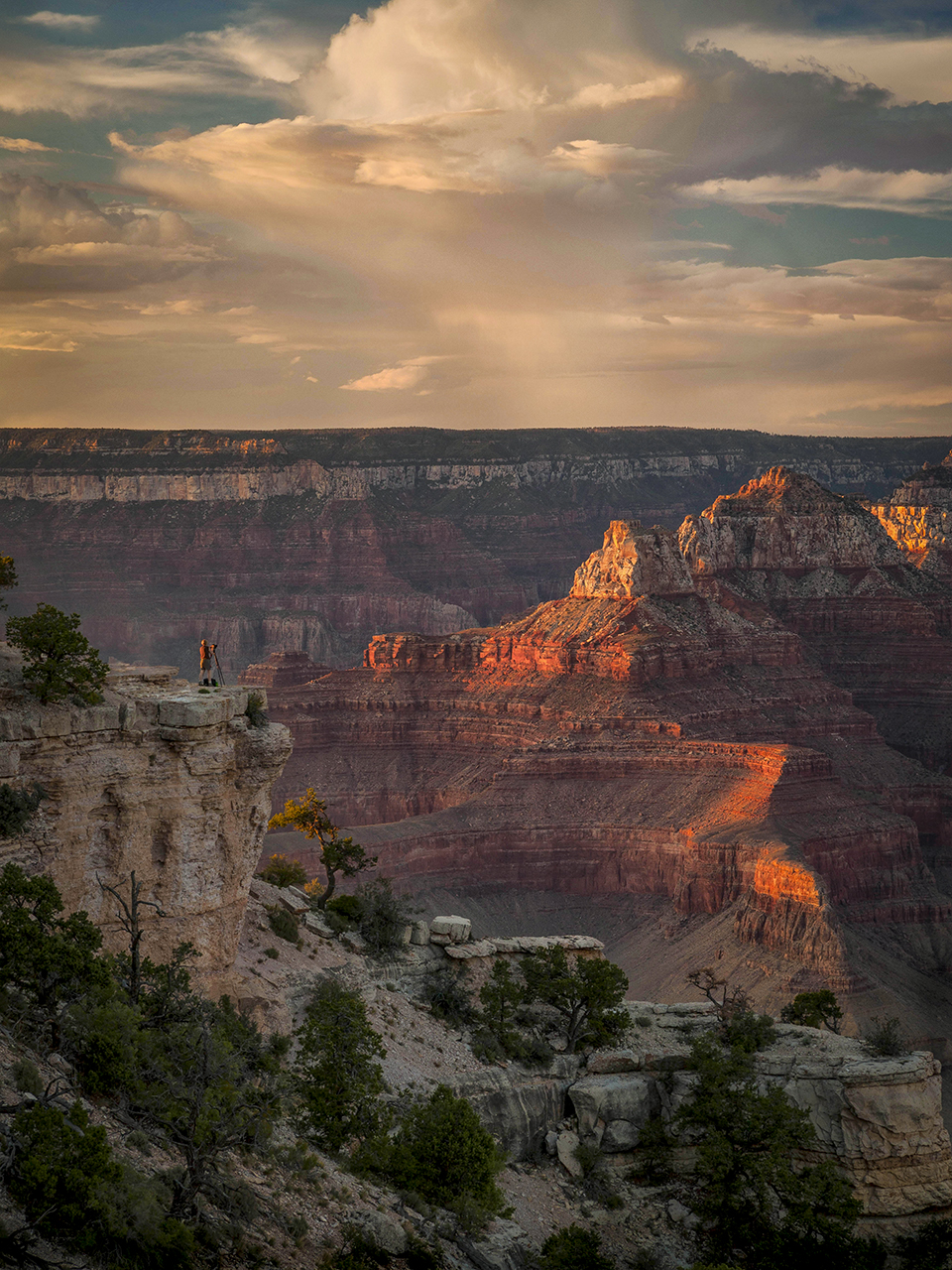
Newly confident, I continue into the park and dodge the large crowds at Mather Point by heading east to the parking area for Shoshone Point, a Canyon overlook I’ve never visited before. I make the easy 1-mile hike, passing lingering patches of snow, before taking in a 270-degree view of the gorge. After the return hike, I continue east, stopping at a handful of car-friendly overlooks along the way, before exiting the park en route to the Cameron area on SR 64.
I watch the Mustang’s range tick down concerningly fast as I pass the snowcapped San Francisco Peaks on southbound U.S. Route 89. Then, I head east on I-40 to Winslow, where my next charging station awaits in a Walmart parking lot. I again get charged up quickly, but range anxiety is about to find me again. My drive from Winslow to Holbrook is mostly uphill and all interstate, which means I’m down to 66 percent by the time I arrive at the teepees of Historic Route 66’s famous Wigwam Motel, my stop for the night.
There’s no Level 3 charger in Holbrook, but with a long drive ahead of me tomorrow, I decide to try out the only available station, a slower, or Level 2, plug-in outside a Days Inn on the north end of town. The difference is obvious: When I return from dinner an hour later, I’ve gained just 11 percentage points — enough for an additional 20 miles or so. Later, I’ll be thankful for that extra mileage, but for now, it underscores the challenges of charging an EV in Arizona’s more remote areas.
Thor Anderson, ADOT’s planning manager, oversees Arizona’s portion of the National Electric Vehicle Infrastructure (NEVI) program, which allocates federal funding for charging stations along highways. Eventually, Anderson says, ADOT envisions using NEVI program funds to install fast chargers at least every 50 miles along most of the National Highway System, a network of federal and state routes that provide access to most of Arizona. That serves the program’s goal of reducing range anxiety by closing gaps in rural areas that currently are unprofitable for charging station developers.
But there are hurdles to achieving that goal. A new Level 3 station typically requires an electrical transformer upgrade, and the supply chain for transformers has been backed up since the COVID-19 pandemic began. Rest areas seem like suitable locations for rural stations, but federal policy currently prohibits that type of commercial activity there. Time-consuming federal requirements have slowed NEVI implementation. And, of course, there’s the installation cost — in the high six figures for a station with four chargers, as the program requires — and the annual upkeep, which averages about $50,000 for a four-charger station.
“There’s some frustration with how long it has taken to get the stations built,” Anderson says. “But a lot of factors have contributed to the delays.” Rising EV popularity, though, could help by giving installers more opportunity to make a profit from a Level 3 charging station — the kind I’m about to wish I had in Holbrook.
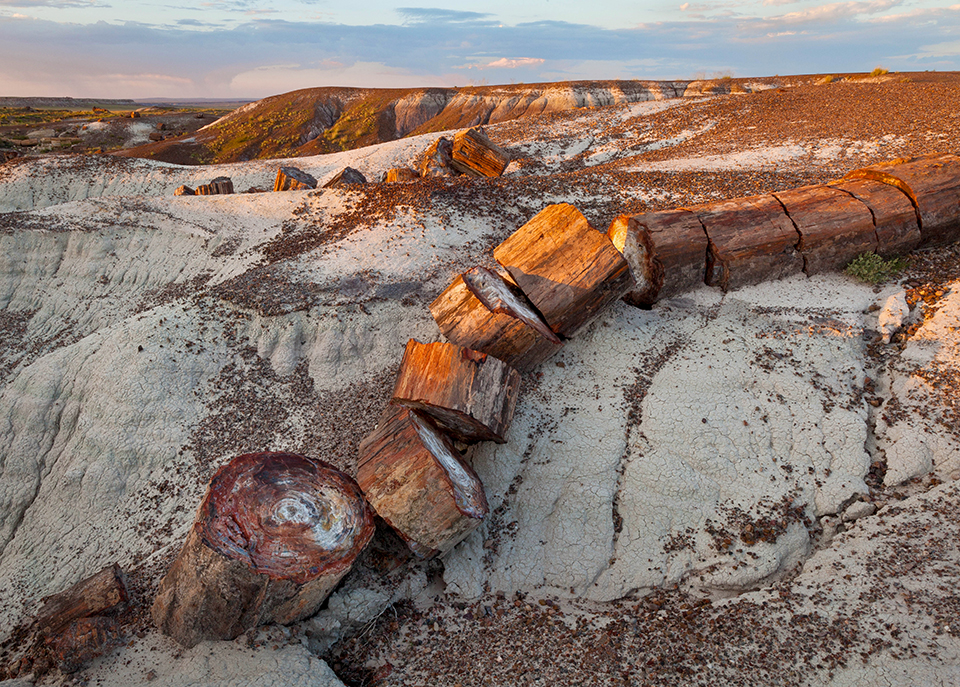
Day 2:
PETRIFIED FOREST NATIONAL PARK
I check out of the Wigwam as the sun rises, then meet photographer John Burcham at the Petrified Forest National Park north entrance around 8 a.m. It’s too cold and windy for hiking — and for glamour shots, as Burcham discovers when he nearly gets blown off his ladder while making photos of the Mustang cruising the park road. But I visit several overlooks on the north side, then continue south to the Tepees, a section of conical, layered buttes in the middle of the park.
It’s here that range anxiety nearly overcomes me. Until now, I’ve been using my phone’s Google Maps app to calculate my route between charging stations, but I now try the Mustang’s onboard software, which finds the nearest station and takes the route into account when calculating the car’s range. The distance to my next charger, in Show Low: 70 miles. The juice left in the car: 71 miles.
A 1-mile cushion doesn’t fill me with confidence, but there’s no appealing alternative. If I return to Holbrook, I’ll have to stay there for hours to give myself much extra range. And if I backtrack farther to Winslow, I’ll be even more behind schedule — but that would be preferable to getting stranded in the hinterlands and needing an expensive tow.
The Petrified Forest area was initially included in Phase 1 of Arizona’s NEVI plan, which awarded federal funds to companies building Level 3 stations on interstate highways. But ADOT didn’t receive a proposal for a station there or in Sanders, farther east on I-40. Eighteen grants were awarded for Level 3 chargers elsewhere on Arizona’s interstates, with construction expected to begin on those by the end of 2025.
None of that helps me right now, so instead of backtracking, I push forward while doing what the car has been lecturing me to do since my I-17 jaunt: slow down. After perusing the petrified logs outside the Rainbow Forest Museum, I exit the park with 50 percent of charge and take U.S. Route 180, state routes 180A and 61, and U.S. Route 60 toward Show Low. The Mustang rates how efficiently I’m driving, and by the time I plug in behind Show Low City Hall, I’ve brought my “speed” grade up to 83 — an achievement for this Arizona State grad — and saved enough power to still have a 23-mile cushion.
It’s another short walk to lunch, and I’m back to 90 percent when I return 43 minutes later. From Show Low, I head south through Salt River Canyon on U.S. 60 — first coasting downhill, then making the Mustang work as I climb toward windy, hazy Globe and my next charge stop, behind Chalo’s Casa Reynoso. My final leg of the day takes me south on scenic State Route 77, past Oracle and Biosphere 2, to the Tucson area. I stop once more, at a fast charger at Tucson Premium Outlets in Marana, before pulling into the Kennedy Hotel on the south side of Tucson around dinnertime. The car is charged, but after a long day on the road, my own battery is approaching zero.
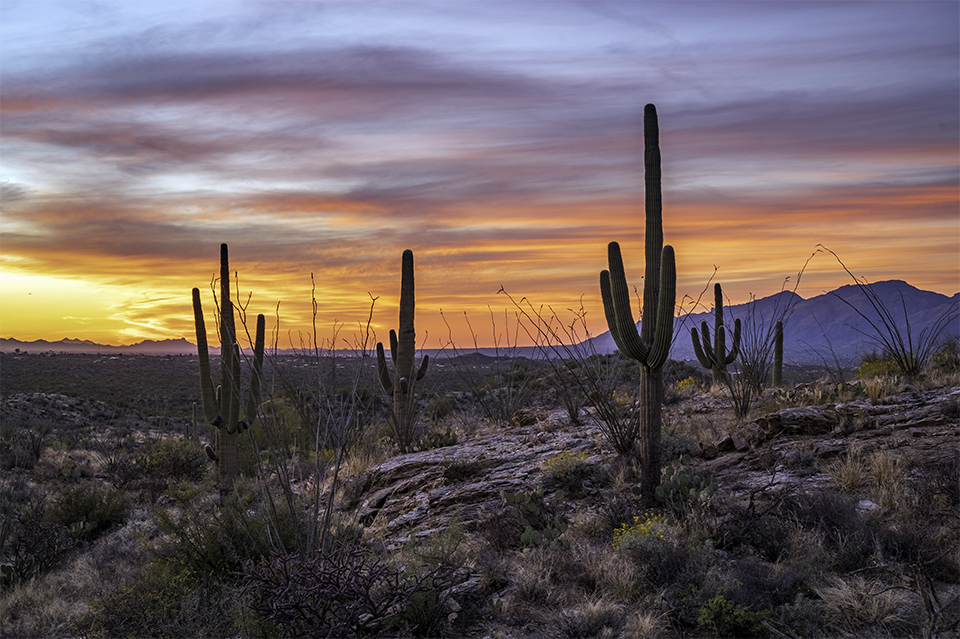
Day 3:
SAGUARO NATIONAL PARK
On a cloudless morning, I leave the hotel around 7:30 a.m. and arrive at Saguaro National Park’s east unit, in the foothills of the Rincon Mountains, by 8. I navigate the park’s Cactus Forest Drive in the Mustang, stopping at the Loma Verde Trailhead for a 3.8-mile loop hike on the Loma Verde, Pink Hill and Squeeze Pen trails. Countless saguaros, prickly pears and blooming ocotillos line my path, and it’s hard to believe I was among ponderosa pines less than 24 hours ago — and staring at the Grand Canyon 24 hours before that.
I exit the park a little before 10 a.m. and make one more stop at the Marana charger to get enough juice for my trip back to Phoenix on Interstate 10. But there’s one more surprise: A crash has closed the freeway, so I detour through Maricopa via state routes 238 and 347, then get back on I-10 just south of the Phoenix area and pull into the ADOT lot at 2 p.m.
I’ve traveled 895 miles in about 15 hours on the road. Additionally, I spent about 4.5 hours, far less than I anticipated, charging the EV — and by multitasking during stops, I was able to keep myself occupied for about half that time. And state officials predict charging times will improve along with EV technology. “The charging speed is not just a function of the charger, but also the car and its capabilities,” Anderson says — something I noticed on my trip, when my charging rate topped out at about a third of what some of the stations said they could provide.
The future of Arizona’s EV infrastructure is harder to predict. After the 18 fast chargers already slated for installation, Phase 2 of ADOT’s NEVI plan includes a further 35 stations spanning the state, from Bullhead City to Springerville and from Page to Douglas. But the federal government paused NEVI funding after President Donald Trump’s inauguration, and ADOT is waiting for new guidance, slated to arrive this spring, before moving forward with the process for those additional sites.
Julie Cruz, the transportation policy adviser for Arizona Governor Katie Hobbs, says the administration will see how the federal uncertainty plays out before determining how the state might address a possible funding gap. Regardless, she says, “It’s very important to the governor to make sure that wherever you are on the highway, you don’t experience that range anxiety.” The Hobbs administration, she adds, sees electric car infrastructure as vital — not just for supporting drivers, but also for attracting jobs in EV-related fields. “This is an exciting era that we’re going into,” Cruz says. “I really hope that in the next five to 10 years, we’re going to continue to grow and improve.”
So, would I recommend visiting Arizona’s three national parks in three days? Probably not. Regardless of the kind of vehicle you drive, such a trip requires a lot of time in the car and less time enjoying nature on its own terms, as Frome would say. But it’s clear that a longer EV trip around Arizona is more realistic now than it’s ever been — and it should only get easier as charging infrastructure continues to catch up with this growing segment of the state’s motor vehicle traffic.
In the meantime, take it easy on your EV’s accelerator while you’re cruising those interstates. You’ve got a lot of road ahead of you.
Electric Vehicle Charging Stations at Arizona’s National Parks
Note: This information is subject to change. EV drivers planning to use these or any other charging stations are advised to confirm they’re working before starting a trip.
Grand Canyon: All of the park’s chargers are Level 2 devices in the Grand Canyon Village area of the South Rim; they can be found near Yavapai and Maswik lodges, and they’re free for park visitors. There’s also a Level 3 charger in Tusayan, just south of the park. There’s no charging available at Desert View or on the North Rim. Information: 928-638-7888, nps.gov/grca
Petrified Forest: A charger once existed at the Rainbow Forest Museum on the south end of the park, but it’s now out of service. The only working charger in the park is outside the visitors center on the north side, but it’s very slow and historically unreliable. The closest charging options outside the park are in Holbrook (Level 2) and Winslow (Level 3). Information: 928-524-6228, nps.gov/pefo
Saguaro: There are no chargers within park boundaries, but numerous Level 2 and Level 3 stations can be found in and around Tucson. Information: 520-733-5153, nps.gov/sagu
Tips for Your Electric Vehicle Road Trip
Because EV charging facilities aren’t as numerous as gas stations, a few extra considerations will help you make a longer road trip in an electric car a success.
Maximize Your Range: The faster you drive and the more weight in the car, the faster you’ll deplete the battery. Stick to the speed limit, particularly when climbing hills, and be smart about the things you’re taking with you. Check your tire pressure before you head out, too, to ensure your car can cover the miles as efficiently as possible.
Be Prepared to Wait: My trip happened in the tourism off-season and on weekdays, which were two reasons I never had to wait in line for a charge. During holiday weekends or busier times of year, that might not be the case, so plan accordingly.
Multitask: By planning charge stops around meal and restroom breaks, you can minimize the time you spend sitting at a charging station. Just make sure you plan to be back at your vehicle by the time it’s sufficiently charged, so you don’t tie up the station for other drivers.
Be Versatile: There are Tesla stations and more generic EV stations all over Arizona, but Teslas use different charging ports than most other EVs. Eventually, new EVs will likely use the Tesla port, but for now, you can buy an adapter to make more stations compatible with your vehicle. Adapters can be purchased for less than $200 online.
